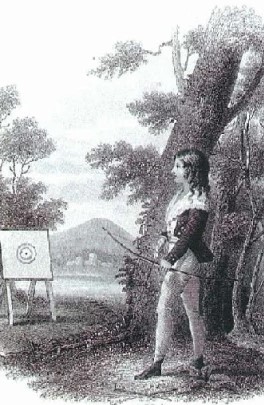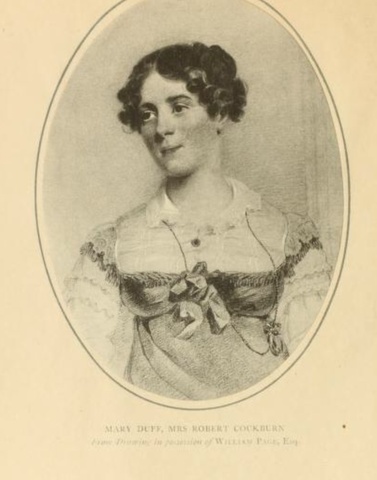
Mary Duff’s House, High Street, Banff
The great poet Lord Byron spent part of his childhood in Banff. His mother’s family lived here. His great-grandmother, Lady Gight, lived in rather an ugly house where the Sheriff Court now stands on Low Street. His first sweet-heart was Mary Duff, who lived on the High Street. There was a public outcry in the 1960s when that house, a really historic 17C tower house, was demolished and replaced by what is now McColl’s. It was because of that philistine decision by our local councillors that the Banff Preservation Society was founded.
Mary was a Duff of Hatton, a very prolific Duff family, cousins of the Earl Fife, and a distant cousin of Byron. She was a few months older than he was, both born in 1788, and they met at a dancing class in Aberdeen. The little boy was lame from birth, so dancing was probably purgatory. But he loved sitting billing and cooing with his pretty cousin.
We know about this because some years later, after inheriting a peerage and going to Harrow, the great English public school, Byron heard that Mary was married. He was a teenager, with his first proper girlfriend (though he said he’d had fifty) and his first proper falling-out with his girl-friend, and he felt totally betrayed. There was his childhood sweetheart, his first love, abandoning him too! It is all in his journal. It did not help matters that his mother then told everyone she met about George’s star-crossed love with Mary Duff.
Here is the story from Byron’s own journal. “I have been thinking lately a good deal of Mary Duff. How very odd that I should have been so utterly, devotedly fond of that girl, at an age when I could neither feel passion, nor know the meaning of the word. And the effect! My mother used always to rally me about this childish amour; and, at last, many years after, when I was sixteen, she told me one day, “Oh, Byron, I have had a letter from Edinburgh, from Miss Abercromby, and your old sweetheart Mary Duff is married to a Mr Co’e.” And what was my answer? I really cannot explain or account for my feelings at that moment; but they nearly threw me into convulsions, and alarmed my mother so much, that after I grew better, she generally avoided the subject—to me—and contented herself with telling it to all her acquaintance. Now, what could this be? I had never seen her since her mother’s faux pas at Aberdeen had been the cause of her removal to her grandmother’s at Banff; we were both the merest children. I had and have been attached fifty times since that period; yet I recollect all we said to each other, all our caresses, her features, my restlessness, sleeplessness, my tormenting my mother’s maid to write for me to her, which she at last did, to quiet me. Poor Nancy thought I was wild, and, as I could not write for myself, became my secretary. I remember, too, our walks, and the happiness of sitting by Mary, in the children’s apartment, at their house not far from the Plain-stanes at Aberdeen, while her lesser sister Helen played with the doll, and we sat gravely making love, in our way. How the deuce did all this occur so early? where could it originate? I certainly had no sexual ideas for years afterwards; and yet my misery, my love for that girl were so violent, that I sometimes doubt if I have ever been really attached since.”
The Mr Co’e was a Robert Cockburn, from a rich family of wine-merchants in Edinburgh – yes, it’s Cockburn’s port. Mary had a happy life, and she outlived Byron by 30-odd years, to die in 1858. She comes into one of Byron’s poems too.

Byron as a boy, engraving from a painting by Kay

